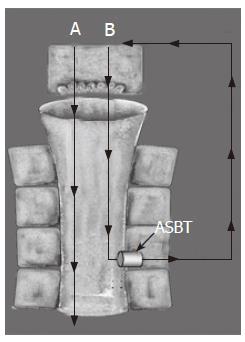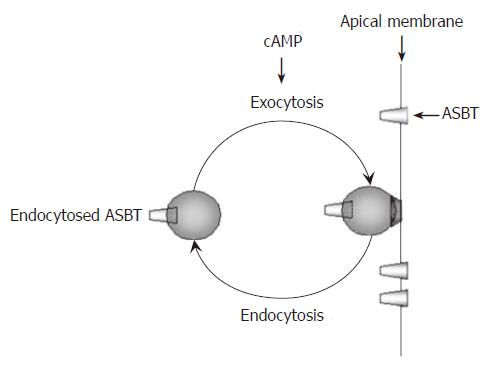Copyright
©2006 Baishideng Publishing Group Co.
World J Gastroenterol. Jun 14, 2006; 12(22): 3553-3563
Published online Jun 14, 2006. doi: 10.3748/wjg.v12.i22.3553
Published online Jun 14, 2006. doi: 10.3748/wjg.v12.i22.3553
Figure 1 Classic cholehepatic shunt pathway (B) compared to direct biliary bile acid secretion (A).
Bile acids that are poor substrates for coenzyme A (CoA) synthetase and inefficiently conjugated by hepatocytes are passively absorbed by biliary epithelium. After canalicular secretion, the unconjugated bile acid is absorbed by cholangiocytes because of the high lipophilicity of the protonated acid. The absorbed bile acid is returned to the hepatocyte mass via the periductular plexus. The osmotic effect of multiple passages of the unconjugated bile acid anions into canalicular bile results in hypercholeresis. The presence of ASBT on the apical membrane of cholangiocytes provides a potential mechanism for absorption of conjugated bile acids that then follows the same shunt pathway as described above.
Figure 2 Membrane recycling of ASBT.
Increased cAMP enhances bile acid uptake in cholangiocytes. Under basal conditions, intracellular ASBT resides in an inactive position within the cytoplasm of cholangiocytes as well as on the apical membrane. Increased cAMP results in translocation of ASBT to the apical membrane where it inserts by exocytosis. Once on the apical membrane, ASBT becomes active and mediates absorption of bile acids from bile. Membrane recycling of ASBT is completed by removal of ASBT from the apical membrane by endocytosis.
- Citation: Xia X, Francis H, Glaser S, Alpini G, LeSage G. Bile acid interactions with cholangiocytes. World J Gastroenterol 2006; 12(22): 3553-3563
- URL: https://www.wjgnet.com/1007-9327/full/v12/i22/3553.htm
- DOI: https://dx.doi.org/10.3748/wjg.v12.i22.3553










